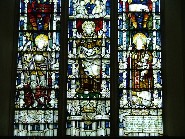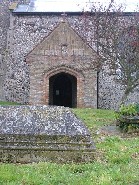| |
|
St Mary,
Newton Flotman
 |
|
This
blockish Perpendicular church is a familiar sight
on its rise high above the A140. At first, you
might think it a completely 19th century affair,
but enough idiosyncrasies survive to suggest that
this Victorian restoration was a renewal rather
than a rebuild. There is a very good late 20th
century addition to the north side, a meeting
room in the style of a great porch, with a triple
lancet of windows. The red brick south porch is
rather more utilitarian. We arrived at the church
to find it a hive of activity; all the hedges
that hid the graveyard from adjacent houses were
being cut down. The reason for this soon became
clear. A few weeks previously, stones had been
thrown through the south nave windows, breaking
glass but aso severing the lead tracery. The
broken glass was just a group of Victorian quarry
tiles, but the windows would need extensive
repair. A couple of handfuls of pebbles had
caused more than ten thousand pounds worth of
damage. |
Since the
best defence of a church is activity, and good neighbours
are those who can see what is going on, the hedges were
coming down; a little too late, alas. The hooligans had
also stamped on the floodlights which make this building
ordinarily such a landmark on the busy road. It has to be
said that, typically of this area immediately to the
south of the city, the church is always kept locked, and
so it wasn't a case of a church being left wide open to
the depredations of vandals and thieves.
Fortunately,
none of the stones had gone through the east or west
windows, for these are some of the best works in the
county of the Kempe workshop. That in the east window is
particularly fine, showing the Risen Christ flanked by St
Michael and St Gabriel. The stones had narrowly missed
three exquisite Continental roundels. These depict St
Margaret, St Stephen, and a King building a church.
  
As you'd expect in this area of Norfolk, our
presence was the cause for a certain amount of suspicion,
but when the lady with the key found out that we were
just enthusiasts, and obviously not international stained
glass thieves, she was very chatty and forthcoming aout
the daily life of the parish, which seems a busy one. She
showed us the great treasure of the church, the massive
Blundeville memorial on the south side of the chancel,
one of those big, pious and yet largely secular
Elizabethan memorials that seem intended to blot out the
sacramental activities of the pre-Reformation Catholic
church, in this case taking the place of what must have
been an Easter Sepulchre. The brass inscription is well
worth a read.
A quiet and, apart from the Kempe glass and
the Blundeville memorial, a simple village church. I was
pleased we'd seen inside. I asked the lady who she
thought had been responsible for the attack, and she
thought for a moment before she suggested that it was
perhaps a gang of kids, or possibly football hooligans.
But she didn't sound convinced, and I wasn't either. The
thing is, this was the third church in this area today
where I had seen windows smashed by thrown stones.
Although the damage elsewhere wasn't as bad as here, I
didn't think it likely that a group of teenagers or
football fans would have bothered to have travelled from
one church to another just to throw stones through
windows. I thought it was more likely that this had been
a deliberate attack on the buildings simply because they
were churches. Over the last year or so, there has been
an increasingly vocal anti-religious strand in English
popular culture. I have heard serious radio programs
where militant and influential humanists have expressed
views of hatred on the subject of organised religion that
have seemed to me near-fascist. The hysterical attack on
faith schools is a case in point. I dread to think what
these people may be legitimising.
It also occured to me that this area of
Norfolk is unusual for having so many locked churches.
Across huge swathes of this great county, the churches
are open all day, every day; that is to say, at least 75%
of the 600-odd churches I have visited in Norfolk so far.
We are told again and again by the church insurance
companies that locked churches are far more likely to
make a claim for damage than unlocked ones. Churches
which are kept locked all day are more likely to be
vandalised, more likely to be broken into, and even more
likely to have something stolen from them. It is as if
open churches, by being welcoming, recruit passers-by,
strangers and pilgrims by giving them a sense of shared
ownership.
In all East Anglia, I had never before come
across anything like this, three churches all near each
other being vandalised in the same way. The incident is
appalling, but It did make me think that if it was
going to happen, then it would probably be in an area of
locked churches like this.
|
|
|




